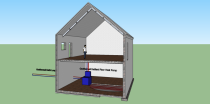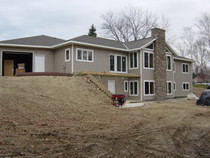( Total Insulated Concrete Form Structure)
TICFS has advanced features such as:
Storm resistance:
Earth quake, Tornado, Hurricanes, Fire.
-
Complete ICF envelope, all exterior walls, and roofs are ICF.
-
Healthy mold free building components.
-
Composite concrete floors/ roof.
-
The monolithic Composite/ICF structure is many times stronger than similar components merrily stacked on top of each other. As is typically built in commercial construction.
-
TICFS was also designed to fit seamlessly into the surrounding neighborhood.
-
Because these structures is so efficient, you will be able to install much smaller geothermal earth loops even on the very small lots. This may not be possible with conventional structures.
ICF Builder Magazine.pdf
Adobe Acrobat document [8.7 MB]
Hud ICF Cost and Benefits Report.pdf
Adobe Acrobat document [2.1 MB]
TABLE 5
COMPRESSIVE STRENGTH DATA
(based on 8-foot wall height)
WALL CONSTRUCTION MAXIMUM COMPRESSIVE LOAD
(pounds per foot of wall length)
Wood Frame (various 2x4 configurations) 4,500 to 10,000
ICF (4- to 6-inch wall thickness) 60,000 to 100,000
Note:
Values are based on unpublished test data and analysis by NAHB Research Center, Inc.
• Wind-borne Debris Impact Resistance
ICF wall systems have been tested for wind-borne debris resistance by subjecting them to the
impact of a 2x4 wood stud traveling at speeds of up to 100 mph. This level of impact is
considered to be representative of the nature of impacts that could be expected in a severe
tornado (i.e., 250 mph wind speed). Data on the wind-borne debris impact resistance of ICF
walls and wood-frame walls is shown in Table 6. While it is possible to upgrade the impact
resistance of standard wood-frame wall construction to levels suitable for protection against
potential debris in moderate hurricanes and less severe tornadoes, it is impractical to upgrade
standard wood-frame wall construction to give comparable performance to ICF walls. It should
be noted that the ICF wall data in Table 6 applies to ICF types that result in a “solid” concrete
wall.
13
TABLE 6
WIND-BORNE DEBRIS IMPACT DATA
WALL CONSTRUCTION IMPACT RESISTANCE
Wood Frame (various typical constructions) 8 to 26 mph (9 lb 2x4)1
ICF (4” and 6” flat and waffle-grid) 100+ mph (15 lb 2x4)2
Notes:
1Based on testing performed by Clemson University for the Region IV Mitigation Division of the
Federal Emergency Management Agency, Atlanta, GA.
2Based on Investigation of Wind Projectile Resistance of Insulating Concrete Form Homes,




